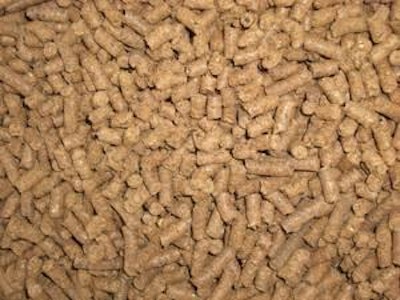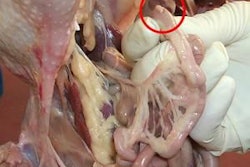
The need to reduce costs and enhance production efficiency and quality in both poultry and swine has led to evaluation of alternatives to conventional antibiotic growth promoters. The trend was accelerated by the unprecedented escalation in the cost of ingredients in 1999. Although prices of the major ingredients have since retreated, recovery from the world-wide recession will undoubtedly increase the cost of feed as the escalating rate of demand outstrips available supplies of grains, oil seeds and animal protein ingredients.
The three classes of additives which are now accepted by nutritionists and producers include enzymes, probiotics and prebiotics. Each class has a specific mode of action and application but in many cases combinations of these compounds are synergistic in providing a benefit greater than the sum of the individual products.
All three classes represent consumer-acceptable performance enhancers (CAPES). In most cases the compounds are generally regarded as safe (GRAS) with unrestricted acceptance by most regulatory authorities.
Enzymes
Enzymes are protein macromolecules which serve as catalysts in either synthetic or degradation reactions. In the context of feed additives, enzymes function within the intestinal tract, breaking down complex molecules to enhance digestibility. Enzymes are highly specific. For example phytase releases phosphorus from phytic acid, allowing the unavailable phytate-bound phosphorus to be digested. Other enzymes are able to degrade non-starch polysaccharides.
Examples are xylanase which breaks down the arabinoxylans which are present in large quantities in wheat and derived products. Proteases and lipases supplement the activity of endogenous digestive enzymes, breaking down storage protein and lipids in the vegetable-derived components of the diet. Adding combinations of enzymes selected for their specific action to diets allows the nutritionist to reduce feed cost. This is achieved by assigning a dummy value for energy, critical amino acids and phosphorus availability to the enzyme complex.
An alternative approach is to increase the nutrient value of ingredients to be incorporated into the diet or to modify nutrient specifications with appropriate reformulation. Irrespective of the nutritionist’s approach enzymes contribute to enhanced feed conversion or growth or alternatively allow standard performance at a lower feed cost.
In the case of phytase supplementation it is possible to reduce the added dietary inorganic phosphorus as mono- or dicalcium phosphate since a high proportion of the vegetable-derived phosphorus will become available. This reduces the quantum of phosphorus excreted. In many areas of the world high concentrations of livestock result in excessive phosphorus release which is responsible for eutrophication of bodies of water. Addition of phytase to feeds is mandated on the Delmarva Peninsula since the apparent problem of phosphorus runoff from using natural and artificial fertilizers has an undesirable ecologic impact on the Chesapeake Bay.
The ultimate aim of a nutritionist is to minimize feed cost per unit of saleable product (eggs, broiler meat, pork) not simply to produce the cheapest feed or to obtain maximum growth or egg production. The general rule of thumb is that an enzyme supplement should generate a three- to four-fold return over the cost of supplementation.
In some cases enzyme additives can enhance product quality in addition to improving growth rate or feed conversion.
Feeding high levels of wheat and wheat product to laying hens is associated with increased viscosity of the ingesta in the ileum and enhanced bacterial degradation of non-starch polysaccharides in the cecum. The net result is the deposition of a dark viscous fluid on the eggshell as it passes through the cloaca. In the U.S. where eggs are washed, the deposits are difficult to remove. The problem is even more severe in the EU where eggs are not washed before packing and the deposits result in downgrading.
Since enzymes are complex proteins, heat applied during pelleting will result in irreversible changes in structure which markedly affect activity. The conformation of the protein structure must allow for the formation of enzyme-substrate complexes on the surface the enzyme.
Accordingly heat-labile enzymes are added in the mixer in the case of mash feeds. Heat stable enzyme preparations can be added to pelleted feeds in the mixer but heat labile enzymes are applied to pellets as a spray. The endogenous enzymes including proteases within the digestive tract degrade dietary enzyme supplements. This necessitates constant inclusion in diets. This characteristic does however ensure that there is no residue problem associated with enzymes added to feed.
Enzyme supplements must be resistant to degradation by mineral components of feed and should be readily dispersed through a diet during mixing. Additional requirements are that enzyme supplements should resist breakdown in the acid environment of the proventriculus and ventriculus in the case of poultry or the stomach of pigs. Optimal activity should be attained over the narrow pH range in the intestinal tract.
Probiotics
Probiotics comprise suspensions of live organism which have beneficial effects within the intestinal tract. These may include competition with pathogens for available binding sites on the enterocytes (cells lining the intestinal tract) or may suppress the proliferation of undesirable bacteria such as the clostridia which produce toxins. Administration of probiotics in the form of direct fed microbials (DFMs) to immature poultry and swine will expedite establishing a beneficial flora.
In some cases DFMs are incorporated into diets to reduce the production of ammonia liberated from manure to the atmosphere of high-rise poultry houses. In the U.S. DFMs containing a defined single or multiple culture fall under the purview of the USDA. Non-defined cultures which were previously available in the U.S. must have the approval of the FDA.
The concern is that non-defined cultures may contain organisms capable of transmitting plasmid-mediated drug resistance. Accordingly extremely high standards are required to demonstrate both safety and efficacy. Effectively there are no non-defined probiotic compounds legally available in the U.S. at the current time. Organisms incorporated into DFMs are selected on the basis of beneficial qualities and are subjected to rigorous evaluations. The most frequently encountered organisms included Bacillus subtilis, Bacillus licheniformis, Lactobacillus acidophilus, Lactobacillus rhamnosus, Bifidobacterium longum and Bifidobacterium thermophilum.
Probiotics may be administered either in feed where thermostability is an obvious consideration or in a liquid suspension added to drinking water. As with all supplements cost effectiveness is critical to commercial acceptability. The benefits from a probiotic may be influenced by intercurrent nutritional and managemental factors which in turn can induce dysbiosis, an imbalance in the composition of the intestinal microflora. Clostridial enterotoxemia is an example of an undesirable change in the composition of flora flavoring Gram-positive toxigenic Clostridium spp. including Cl. perfringens and Cl. colinum in poultry with other clostridial counterparts in mature swine.
Prebiotics
Applying the definition of the pioneer in the field of prebiotic therapy, Marcel Roberfroid defined the class of compounds as “selectively fermented ingredients that allow specific changes in the composition and activity of microflora in the intestinal tract conferring benefits to the host.” Prebiotics are complex carbohydrates with the fructooligosaccharides (FOS) and the mannonoligosaccharides (MOS) the most frequently encountered commercial forms.
The later are usually derived from the outer cell wall of the yeast Saccharomyces cerevisiae. Mannonoligosaccharides have a multiple function in the intestinal tract. Apart from stimulating the proliferation of beneficial flora such as the Lactobacillus spp. and Bifidobacterium spp. MOS can selectively agglutinate organism with Type 1 fimbriae. It has been demonstrated that most of the Salmonella spp. and some other pathogens which bind to the mannan receptocytes on enterocytes can be cleared from the intestinal tract by addition of MOS to diets.
There are also direct or indirect actions on immune regulation within the intestinal tract, enhancing the response to pathogens. Although MOS has no direct effect on Clostridum spp. inclusion of this prebiotic to diets can reduce both the incidence rate and severity of clostridial enterotoxemia.
The beneficial effect of prebiotics on the intestinal tract can be demonstrated by increased height of intestinal villi, a reduced turnover rate of enterocytes as denoted by the ratio of villus height to crypt depth. Irrespective of the physiological and histomorphologic effects which can be measured following addition of a prebiotic to a diet, improved feed conversion efficiency, growth rate and livability represent the most important criteria of success, justifying the use of prebiotics.
Recently combinations of a probiotic and prebiotic have become commercially available, positioned directly against antibiotic growth enhancers. The economic justification and beneficial result from the use of either prebiotics or probiotics or their combination will depend on intercurrent flock health which in turn is a function of housing, equipment, management, biosecurity, vaccination and microclimate.
Appraisal
Enzymes, probiotics and prebiotics have the potential to enhance productivity and economic return. Inexorably AGPs are being subject to greater legislative scrutiny resulting in restrictions and consumer rejection.
Alternatives including the three classes of alternative compounds must be shown by appropriate scientific protocols to be both effective and safe. Products should be supplied by reputable companies and should be supported by technical and analytical services. Price is of less importance than efficacy in order to obtain a desirable benefit to cost ratio.

















